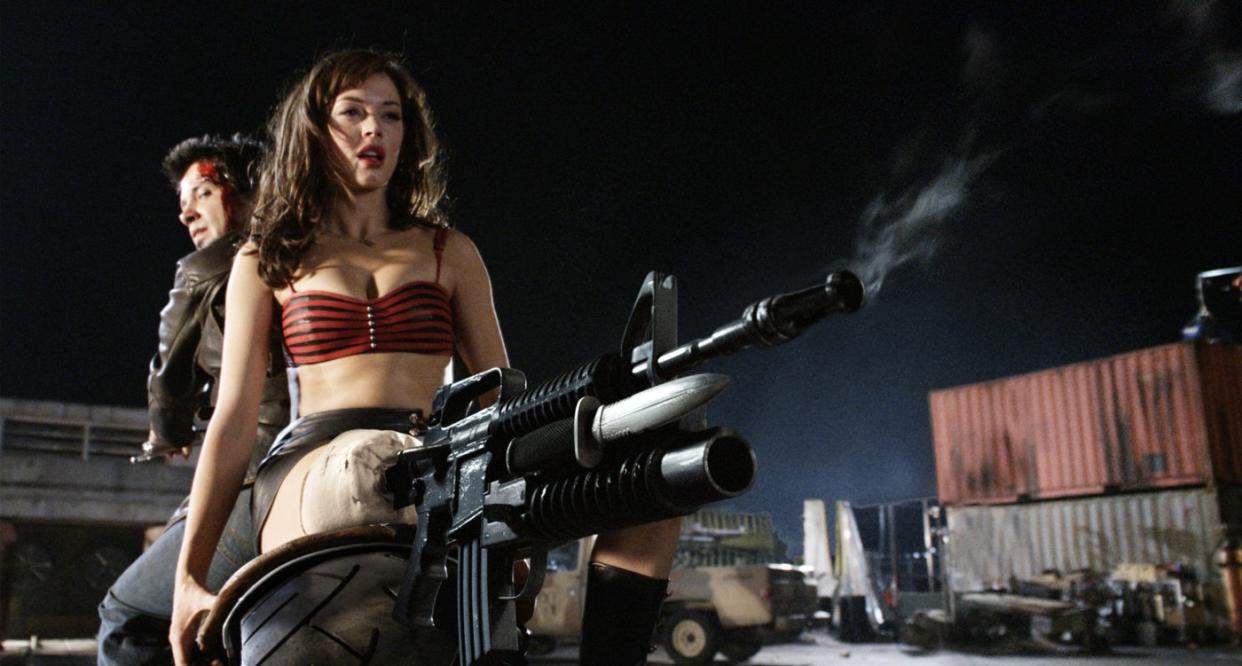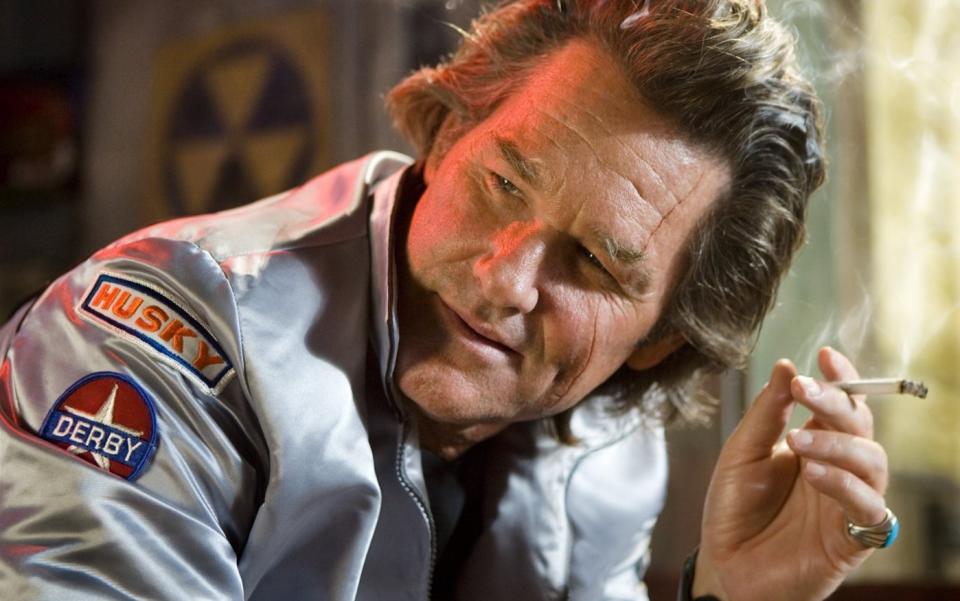Tarantino & Rodriguez flop Grindhouse proved more influential than you might have thought

Ten years after it crashed and burned at the box office, exploitation double bill ‘Grindhouse’ has made a greater impact on movies and pop culture in general than anyone would have expected.
It seemed like a sure thing. Quentin Tarantino and Robert Rodriguez had been two of the most celebrated newcomers in indie filmmaking in the 1990s. After their respective debuts ‘Reservoir Dogs’ and ‘El Mariachi’ premiered alongside one another at the 1992 Sundance Film Festival, the two became firm friends, later collaborating on 1997’s cult horror favourite ‘From Dusk Till Dawn.’
By the mid-2000s, both directors were at the top of their game critically and commercially, Tarantino having successfully returned from a ‘wilderness years’ period with the two-volume ‘Kill Bill,’ whilst Rodriguez enjoyed his biggest hit in ‘Sin City’ (in which Tarantino had served as ‘guest director’ on one sequence). As such, news that the duo would reunite once again on a large scale, unorthodox horror movie double bill – Rodriguez’s zombie movie ‘Planet Terror,’ and Tarantino’s slasher ‘Death Proof’ – was enough to work up the online fan community into a frenzy of anticipation.
Alas, when ‘Grindhouse’ (budgeted at $67 million) opened in US cinemas on 6 April 2007, it was to the tune of an $11.5 million opening weekend – less than half of what ‘Sin City’ and the ‘Kill Bill’ movies had opened to. This dropped off even further as the weeks went on, and by the end of its US run ‘Grindhouse’ had barely made $25 million. Nor did the international box office add much, as the Stateside failure led to Dimension Films scrapping plans to release the double bill in the same format internationally, instead releasing the two films individually to a similarly underwhelming commercial reception.

Quite why ‘Grindhouse’ failed so spectacularly was immediately the subject of much debate, some questioning the choice of opening at Easter, others blaming the three hour running time; but it seems the key problem, as is so often the case with films that flop on release only to see their reputation improve with time – say, ‘Blade Runner,’ ‘The Shining,’ or John Carpenter’s ‘The Thing’ – is that the cinemagoers of the day just didn’t quite get it.
Now, it’s arguable whether ‘Grindhouse’ necessarily warrants being mentioned in the same breath as any of those aforementioned genre classics. Perhaps a better frame of reference might be Walter Hill’s ‘Streets of Fire,’ or for a more recent example Edgar Wright’s ‘Scott Pilgrim vs The World;’ these, like ‘Grindhouse,’ were big budget studio productions which were clearly geared toward a very niche audience from the get-go. However, in its own way ‘Grindhouse’ has become something of a benchmark film, proving highly influential on the horror cinema that has followed in the years since; and arguably its echoes can be felt even further.
One of the key things that confused audiences at the time was the oddball aesthetic of ‘Grindhouse.’ As implied by the title, Tarantino and Rodriguez sought to evoke the spirit of the old school grindhouse theatres that had played sleazy, low-budget horror and exploitation movies in the years before home video took over. These screenings typically used battered, well-worn 35mm prints which had been toured up and down the nation, played on similarly rickety film projectors.

To emulate this, the digitally-shot ‘Grindhouse’ films were augmented with artificial scratches on the image, deliberate shake and focus pulls, missing frames, and most notoriously a few completely missing scenes: ‘Planet Terror’ teasingly cuts out during a sex scene, and misses out a vital plot development which remains ambiguous to the end, whilst the initial cut of ‘Death Proof’ cut out the famous lap dance sequence, ultimately restored when the film was released solo.
Opening weekend viewers may have been left baffled, thinking the film was just badly made, but it didn’t take long for this approach to catch on. Low budget indie horror filmmakers were the first to adopt a ‘Grindhouse’-esque neo-retro approach, some very successfully (‘Dear God No!’), others somewhat less so (‘Bitch Slap’).
Perhaps most notably, despite being an ostensible flop, ‘Grindhouse’ wound up spawning three theatrically-released spin-off movies: Robert Rodriguez’s ‘Machete’ and ‘Machete Kills,’ and Jason Eisener’s ‘Hobo with a Shotgun,’ all of which were developed from fake trailers featured during the double bill (the original ‘Hobo’ fake trailer having been the winner of a fan contest held at the SXSW festival, which wound up being shown in some ‘Grindhouse’ screenings in Eisener’s native Canada). Further fake trailers were contributed by Edgar Wright, Eli Roth and Rob Zombie.

In addition, the ‘Grindhouse’ style soon caught on in TV advertising and music videos. Most famously, the videos for Lady Gaga and Beyonce’s ‘Telephone’ and Rihanna’s ‘Bitch Better Have My Money’ very much adopted a vintage exploitation movie look and feel. Iggy Azalea paid most direct homage to ‘Grindhouse,’ recreating the ‘Death Proof’ lapdance in her video ‘Work.’
The years since ‘Grindhouse’ have also seen a widespread resurgence of interest in underground exploitation and horror cinema from decades gone by. Blu-ray and DVD labels such as Britain’s Arrow Video and Shameless Screen Entertainment and the USA’s Scream Factory have reissued countless cult titles of the 1970s and 80s, whilst most horror film festivals tend to include at least a few vintage titles in their line-up.
Retro influences remain prominent in today’s genre fare. Anna Biller’s acclaimed recent release ‘The Love Witch’ was noted for its painstaking recreation of a late 1960s aesthetic. More commonplace is the influence of the 1980s, prominent in the films of Nicolas Winding Refn (‘Drive,’ ‘Only God Forgives,’ ‘The Neon Demon’), widely praised 2015 horror ‘It Follows,’ and – surely the most popular of all – The Duffer Brothers’ Netflix series ‘Stranger Things.’ These in turn draw heavily on the synthwave music scene, a revival of 80s-style electronica heavily inspired by genre film soundtracks from the likes of John Carpenter, Vangelis and Tangerine Dream.

It would of course be a major stretch to hold ‘Grindhouse’ solely responsible for all of this, but there’s no denying that it had a key role to play. All this being the case, it does seem ironic that it initially proved a bit of a setback for Quentin Tarantino and Robert Rodriguez, who have not collaborated again since. Tarantino managed to bounce back beautifully with ‘Inglourious Basterds,’ ‘Django Unchained’ and ‘The Hateful Eight,’ and reportedly plans to make only two more films before retiring.
Rodriguez (who caused a minor scandal by leaving his wife for actress Rose McGowan whilst shooting ‘Grindhouse’) seemed to take a little longer to recover. He was unable to finance his planned remakes of ‘Barbarella’ and ‘Red Sonja,’ whilst the ‘Machete’ movies and ‘Sin City: A Dame to Kill For’ proved underwhelming. However, he looks set to come back in a big way with the James Cameron-produced ‘Alita: Battle Angel,’ which he’s poised to follow with a remake of ‘Escape From New York.’
Regardless of whether ‘Grindhouse’ is ever held up as a career highlight for either filmmaker, it remains an entertaining oddity, and proof positive that a film’s long-term merit can never be measured by its opening weekend.
Read More:
Every movie Dwayne Johnson has in the works right now
Latest photos from Pirates 5
Schwarzenegger: no Expendables without Sly

 Yahoo Movies
Yahoo Movies 

